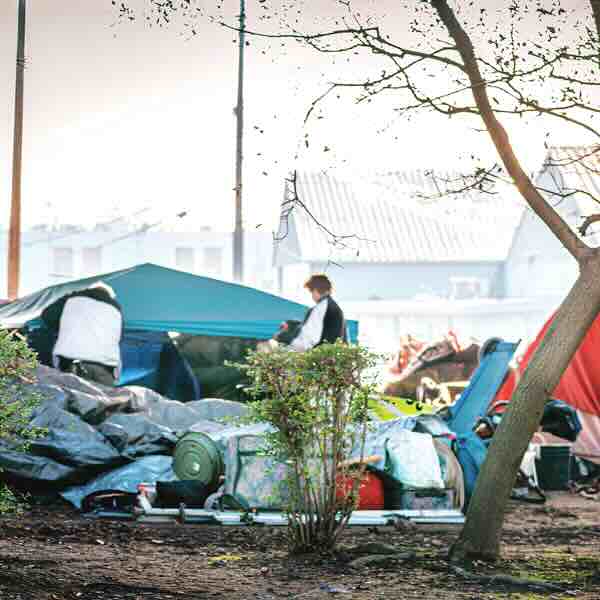No other local news outlet has covered the unsheltered crisis better than on our pages, a commitment we made in 2019. Sadly, most of the news has been grim if not hopeless.
But in recent months, we’ve seen changes that might turn the tide.
“Americans With No Address” is a new, compelling documentary on the national unsheltered crisis. I watched it on Amazon Prime and urge you to see it.
Produced by Robert Craig Films, the work dives deep into homelessness. The film was created from a three-week bus tour—starting in Sacramento—across 20 cities in 18 states. The filmmakers explore causes behind homelessness. And they find solutions.

The documentary reveals the staggering scale of the crisis, with more than 2.8 million people experiencing homelessness in 2023. Over half are children.
Trauma, mental health problems, substance abuse, lack of affordable housing and economic hardship are detailed.
The film debunks stereotypes that all homeless people are addicts or mentally ill. It shows how everyday citizens get caught in unfortunate circumstances. Humanity and resilience are emphasized.
“Americans With No Address” focuses on solutions, spotlighting the work of faith-based and secular nonprofits, including The Salvation Army, where I serve on the local community advisory board.
These organizations provide housing, supportive services, rehabilitation and counseling at a fraction of government costs—sometimes as low as $21 a day per person. They often lack access to public funds.
The film criticizes government efforts, noting despite a tripling of dollars over the previous 12 years homelessness rose 12% in 2023. Clearly, bureaucratic policies such as the federal and state “Housing First” strategy worsened the problem.
Sacramento spends $50 million a year on homeless services. Yet the unsheltered population has skyrocketed. Accountability and auditing are nonexistent.
Housing First was implemented nationally in 2004 under President George W. Bush to combat chronic homelessness. It expanded under President Obama as the country’s plan of attack on homelessness and continued through President Biden. This happened while the largest homeless encampment in the U.S. was one block from the White House.
Housing First aims to stabilize homeless people in permanent housing and provide them with case management support and social services without forcing treatment, imposing job requirements or demanding sobriety.
Once housed, formerly unsheltered people escape street chaos and find jobs. They take care of chronic health conditions and get sober.
Or so the Housing First theory goes.
But after two decades and billions of dollars, Housing First is a bust.
The Trump administration is implementing a new approach to get homeless people off the streets, forcibly moving unhoused individuals into large camps while mandating mental health and addiction treatment.
Housing First is under attack from Republican and Democrat politicians. Conservatives have long criticized taxpayer-subsidized housing for homeless people. Progressive mayors who run major cities struggle to respond to public frustration over widespread encampments.
California voters approved Proposition 36 last year, restoring consequences for people who fail to accept help. The law lets judges require chronic drug offenders to complete treatment as an alternative to incarceration. It offers access to specialists, shelters and job training. Criminal records can be expunged with completion of treatment programs.
Gov. Gavin Newsom created a “CARE Court” that mandates treatment when housing isn’t available. He threatened to withhold money from cities and counties that don’t clear encampments.
San Jose Mayor Matt Mahan won support from his City Council to arrest people who refuse shelter three times in 18 months. The city diverts permanent housing funds to pay for more homeless shelters.
San Francisco Mayor Daniel Lurie wants to eliminate “harm reduction” programs that encourage open-air drug use. The city spent $27 million on unsupervised outdoor spaces with free needles and paraphernalia. Drug dealers operate through fences that cordon off the area. They will be replaced with Recovery First programs.
Last summer, the Supreme Court overturned Martin v. Boise. Now cities can clear and cite homeless camps on public property without offering shelter beds.
As a result, Sacramento County Sheriff’s deputies and park rangers can move homeless people without a guaranteed shelter bed. County Supervisor Rich Desmond said the decision would “allow prioritization be done by law enforcement on encampments that are particularly problematic.”
Housing First failed. New strategies to combat homelessness are emerging. Let’s hope local leaders use more thoughtful options to finally solve this horrible situation.
Readers ask how they can contribute to Inside Sacramento. Here’s how: Consider a paid supporting membership starting at $19.95 a year. Use the QR code and help support our mission to deliver local news.
Cecily Hastings can be reached at publisher@insidepublications.com. Follow us on Facebook and Instagram: @insidesacramento.















